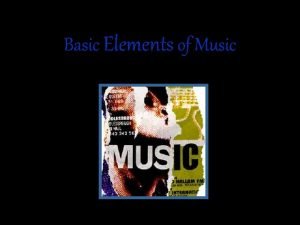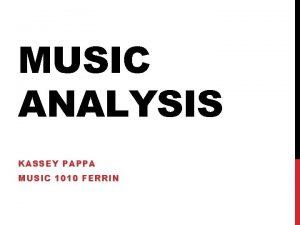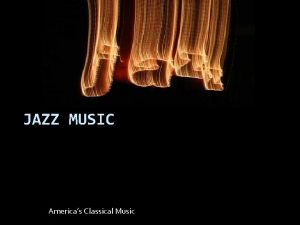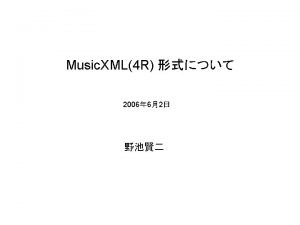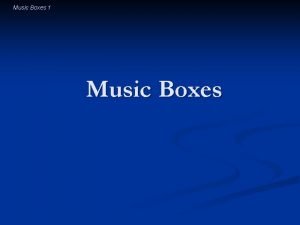The Elements of Music The Elements of Music













- Slides: 13

The Elements of Music

The Elements of Music • The elements of music are just like the ingredients in a recipe that every composer has at their disposal. Just as no two recipes are exactly the same; no two composers use the elements in exactly the same way.

The Elements of Music 1. Melody: a series of notes that add up to a recognizable whole. It is the tune of a piece. 2. Rhythm: musical time (sounds organized according to duration) 3. Harmony: the combination of simultaneous notes (chords) and their relation to each other. 4. Texture: a pattern of musical sound created by notes or lines of music played or sung together. 5. Timbre: the characteristic quality of sound produced by a particular voice or instrument. 6. Dynamics: the approximate volume, or loudness, of a sound. 7. Form: the structure or “roadmap” of the music

Melody/Pitch • Pitch refers to the degree of a note. • Melody refers to the linear series of pitches moving through time in a piece of music. • Melodic contour describes the direction (up or down) in which the pitch moves whether by step (scale), skip (interval), or repetition (rhythmic use of one repeated note)

Rhythm/Duration • Element of TIME • Aspects include: – – Beat, Pulse or Rhythm Duration: how long a sound/rest lasts Metre (grouping of beats into a time signature) Tempo (speed) of the piece. • These aspects of a piece can be: – Static (steady rhythmic pulses, unchanging tempo) – Fluid (multiple time signatures, speeding up or slowing down, accelerando/ritardando)

Harmony • Harmony is the simultaneous sounding of two or more notes. (verticalization of pitch) • Harmony relates to the tonality of a piece of music: – Ex. Major, minor, modal, or atonal, – Consonance (sooth-sounding harmony) – Dissonance (harsh-sounding harmony) • It also relates to the structure of how that harmony works throughout the entire piece

Texture • Texture relates to the number of parts being played or sung simultaneously, and the relationship between them. • This can be seen as the “horizontal” aspect of the music (a single melody line) relating to the “Vertical” aspect (layering of notes/chords) • There are three main types of texture: – Monophony is when there is just a single melody – Homophony is a melody with an accompaniment – Polyphony is the layering of multiple melodies at once

Timbre/Tone Colour • Timbre/tone colour refers to the unique qualities of different sounds – Ex. the difference between two voices – Ex. The difference between a trumpet and a clarinet playing the same pitch

TIMBRE GAME! Create a circle and have a volunteer stand in the middle and spin around with their eyes closed. Three chosen students will shout one compliment to their peer and may warp their voice so hide their identity. The person standing in the center of the circle must then guess who spoke!

Dynamics • Dynamics are the degrees of volume present in a piece of music. • These can be static volume levels, such as forte or mezzo piano, or more gradual changes in dynamics such as crescendo and decrescendo.

Form • Form refers to the overall structure or plan of a piece of music. – Ex. In “Pop” music, songs tend to have a verse and a chorus and alternate between those sections. – Classical music is very similar and is often organized into different sections. • Ex. A Band piece with a slow opening followed by a fast section. This piece is considered to be in “Binary” form • Ex. A Band piece with a fast opening, a slow middle, and an ending that is a repeat of the fast opening. This is considered to be in “Ternary” form.


Melody Rhythm Describe the Musical Elements! • https: //www. youtube. com/watch? v=ydpmz. U_i 2 hg Harmony Texture • https: //www. youtube. com/watch? v=a. E 2 GCa-_ny. U • https: //www. youtube. com/watch? v=x 2 h 46 Dz. VA 2 Q • https: //www. youtube. com/watch? v=-y. L 7 VP 4 -k. P 4 Timbre • https: //www. youtube. com/watch? v=Dw. Hp. DOWhk Gk Dynamics • https: //www. youtube. com/watch? v=n. U-Ghfe. WSP 8 Form
 Music music music
Music music music 8 elements of music
8 elements of music Classical music vs romantic
Classical music vs romantic Employs electronic musical instruments
Employs electronic musical instruments Ilocano folk song pamulinawen
Ilocano folk song pamulinawen Thơ thất ngôn tứ tuyệt đường luật
Thơ thất ngôn tứ tuyệt đường luật Hổ đẻ mỗi lứa mấy con
Hổ đẻ mỗi lứa mấy con Thế nào là hệ số cao nhất
Thế nào là hệ số cao nhất Diễn thế sinh thái là
Diễn thế sinh thái là Vẽ hình chiếu vuông góc của vật thể sau
Vẽ hình chiếu vuông góc của vật thể sau Frameset trong html5
Frameset trong html5 Làm thế nào để 102-1=99
Làm thế nào để 102-1=99 Lời thề hippocrates
Lời thề hippocrates Vẽ hình chiếu đứng bằng cạnh của vật thể
Vẽ hình chiếu đứng bằng cạnh của vật thể
















